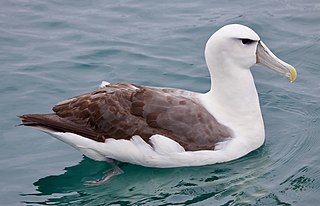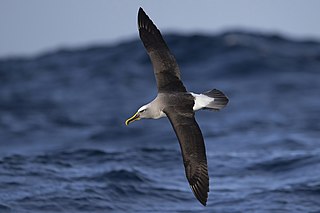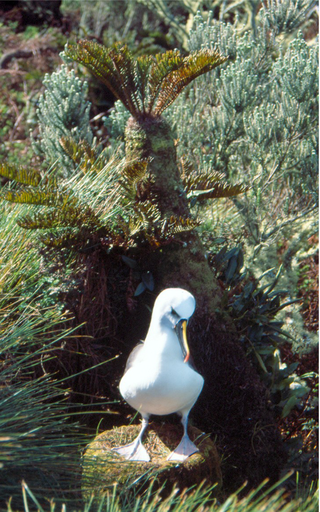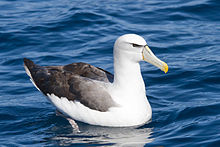
The black-browed albatross, also known as the black-browed mollymawk, is a large seabird of the albatross family Diomedeidae; it is the most widespread and common member of its family.

Pachyptila is a genus of seabirds in the family Procellariidae and the order Procellariiformes. The members of this genus and the blue petrel form a sub-group called prions. They range throughout the southern hemisphere, often in the much cooler higher latitudes. Three species, the broad-billed prion, the Antarctic prion and the fairy prion, range into the subtropics.

The Chatham albatross, also known as the Chatham mollymawk or Chatham Island mollymawk, is a medium-sized black-and-white albatross which breeds only on The Pyramid, a large rock stack in the Chatham Islands, New Zealand (Aotearoa). It is sometimes treated as a subspecies of the shy albatross Thalassarche cauta. It is the smallest of the shy albatross group.

Salvin's albatross or Salvin's mollymawk, is a large seabird that breeds mainly on the Bounty Islands of New Zealand, with scant amounts on islands across the Southern Ocean. A medium-sized mollymawk, it was long considered to be a subspecies of the shy albatross.

The North Pacific albatrosses are large seabirds from the genus Phoebastria in the albatross family. They are the most tropical of the albatrosses, with two species nesting in the Northwestern Hawaiian Islands, one on sub-tropical islands south of Japan, and one nesting on the equator.

The white-capped albatross is a mollymawk that breeds on the islands off of New Zealand. Not all experts agree that this form should be recognized as a separate species from the shy albatross, Thalassarche cauta. It is a medium-sized black, slate gray, and white albatross and is the largest of the mollymawks.

Buller's albatross or Buller's mollymawk, is a small mollymawk in the albatross family.

The light-mantled albatross also known as the grey-mantled albatross or the light-mantled sooty albatross, is a small albatross in the genus Phoebetria, which it shares with the sooty albatross. The light-mantled albatross was first described as Phoebetria palpebrata by Johann Reinhold Forster, in 1785, based on a specimen from south of the Cape of Good Hope.

The Campbell albatross or Campbell mollymawk, is a medium-sized mollymawk in the albatross family. It breeds only on Campbell Island and the associated islet of Jeanette Marie, in a small New Zealand island group in the South Pacific. It is sometimes considered a subspecies of the black-browed albatross. It is a medium-sized black and white albatross with a pale yellow iris.

The Indian yellow-nosed albatross is a member of the albatross family, and is the smallest of the mollymawks. In 2004, BirdLife International split this species from the Atlantic yellow-nosed albatross; however Clements has not split it yet, and the SACC has not either, but recognises the need for a proposal.

The Atlantic yellow-nosed albatross is a large seabird in the albatross family Diomedeidae.

The northern royal albatross or toroa,, is a large seabird in the albatross family. It was split from the closely related southern royal albatross as recently as 1998, though not all scientists support that conclusion and some consider both of them to be subspecies of the royal albatross.

The southern royal albatross or toroa, is a large seabird from the albatross family. At an average wingspan of above 3 m (9.8 ft), it is one of the two largest species of albatross, together with the wandering albatross. Recent studies indicate that the southern royal albatross may, on average, be somewhat larger than the wandering albatross in mass and have a similar wingspan, although other sources indicate roughly similar size for the two species and the wandering species may have a larger average wingspan in some colonies.

The fairy prion is a small seabird with the standard prion plumage of blue-grey upperparts with a prominent dark "M" marking and white underneath. The sexes are alike. It is a small prion which frequents the low subantarctic and subtropic seas.

The white-chinned petrel also known as the Cape hen and shoemaker, is a large shearwater in the family Procellariidae. It ranges around the Southern Ocean as far north as southern Australia, Peru and Namibia, and breeds colonially on scattered islands. The white-chinned petrel was formerly considered to be conspecific with the spectacled petrel.

The broad-billed prion is a small pelagic seabird in the shearwater and petrel family, Procellariidae. It is the largest prion, with grey upperparts plumage, and white underparts. The sexes are alike. It ranges from the southeast Atlantic to New Zealand mainly near the Antarctic Convergence. In the south Atlantic it breeds on Tristan da Cunha and Gough Island; in the south Pacific it breeds on islands off the south coast of South Island, New Zealand and on the Chatham Islands. It has many other names that have been used such as blue-billed dove-petrel, broad-billed dove-petrel, long-billed prion, common prion, icebird, and whalebird.

The Antarctic prion also known as the dove prion, or totorore in Māori, is the largest of the prions, a genus of small petrels of the Southern Ocean.

The slender-billed prion or thin-billed prion, is a species of petrel, a seabird in the family Procellariidae. It is found in the southern oceans.

The fulmar prion is a species of seabird in the family Procellariidae, found in the southern oceans.

Salvin's prion, also known as the medium-billed prion, is a species of seabird in the petrel family Procellariidae.
































